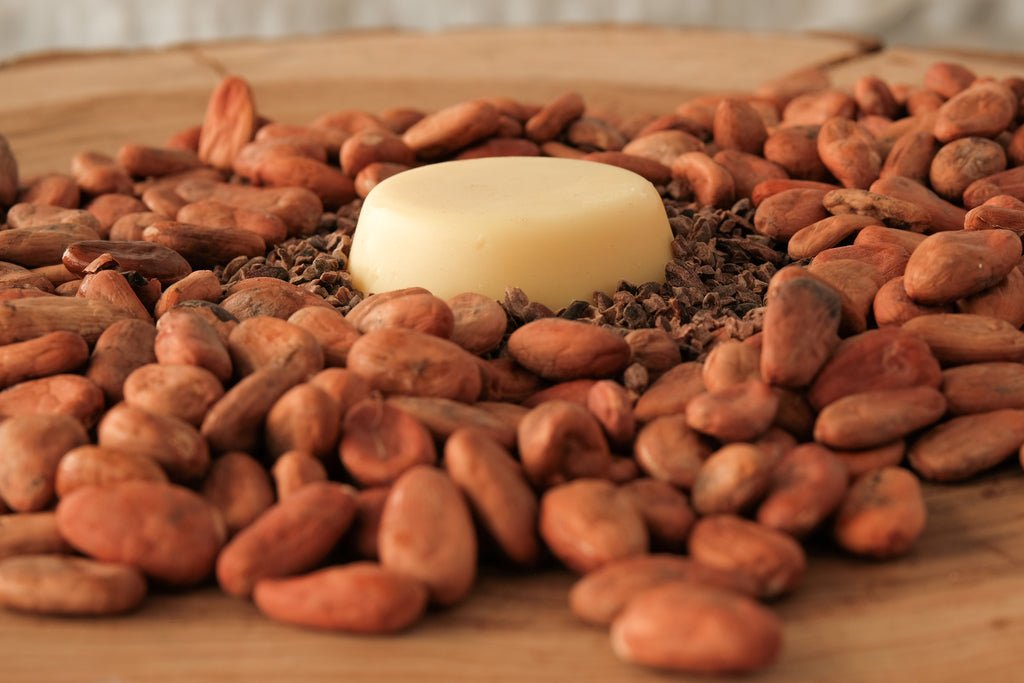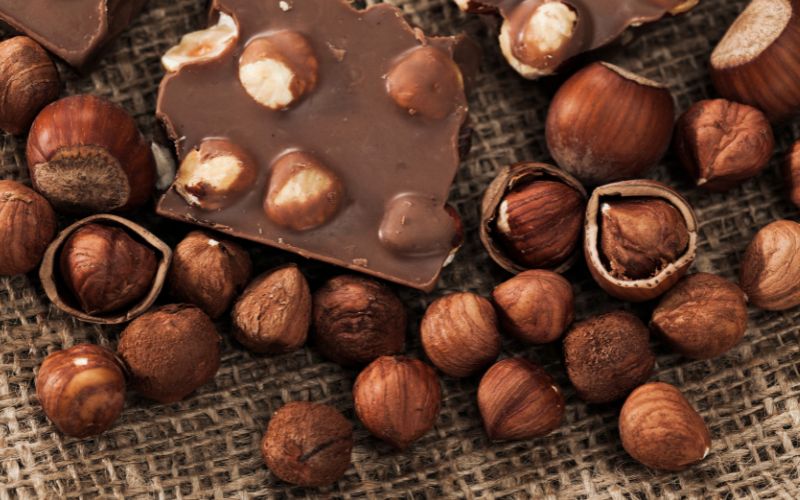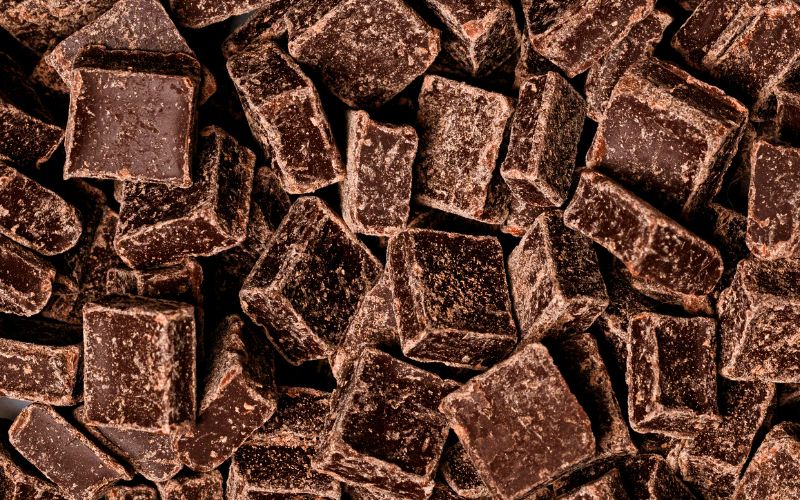What is Cacao Butter or Cocoa Butter? Are They the Same Thing?
What is the right way to say it? Cacao Butter or Cocoa Butter? The term cacao butter and cocoa butter are used interchangeably. Typically when chocolate is in its raw state, we use the term cacao. For purposes of this article we will use the term cacao butter.
Traditional unprocessed chocolate, on average, is over 50% fat. In order to diversify the divine bean of Central and South America (and now Africa), most commercial chocolate has this fat pressed out. This separates the cacao bean into two products, a lighter and less nutritionally dense cocoa liquor/powder, and cacao butter.
Although separated, many of the nutritional benefits of chocolate come from its natural occurring fats. So when the fat is pressed out of chocolate and left to cool, many of the nutrients inherent in unprocessed chocolate are pressed out with the fat, creating the antioxidant and nutrient rich cacao butter.

Pure, non artificially enhanced cacao butter is edible, with a mildly sweet taste and a light chocolate aroma. Loaded with a variety of antioxidants and natural minerals, cacao butter is fantastic for cooking and great for the skin. It is rare to find such a versatile naturally occurring substance that provides substantial benefits in all of its uses.
Cocoa butter boasts a unique composition that plays a significant role in its skin-loving properties. It primarily contains saturated fatty acids, oleic acids, and stearic acids. These components contribute to its solid texture at room temperature, which melts upon contact with the skin, allowing for easy application.
Cocoa Butter for Skin Hydration: Myth or Reality?
If you're seeking deep hydration for your skin, cocoa butter might just be the solution you've been looking for. Its rich texture makes it an excellent emollient, forming a protective barrier on the skin's surface to lock in moisture. Regular application can help keep your skin supple and hydrated, especially in dry or cold weather.
What are the Benefits of Cocoa Butter for Skin
Cocoa butter doesn't just stop at hydration – it also possesses soothing properties. It contains natural antioxidants that help calm irritated skin, making it a suitable choice for individuals with sensitive skin. Additionally, the antioxidants offer a degree of protection against environmental stressors.
In youth, our skin naturally produces a multitude of antioxidants. Some, such as Vitamin E, protect us from UV rays, while others, such as Vitamin C, even out skin tone and reduce the appearance of fine lines.

Skin ages as we get older. Many skincare products do not effectively absorb into our skin, instead functioning as short term solutions for persistent problems. They provide buoyancy for a day or hour, but not for significant periods of time. Since the UV light that breaks down the naturally occurring Vitamin C on our skin does the same to the Vitamin C in the skincare products we apply, many “anti-aging” or “wrinkle reversing” products remain temporary solutions.
Polyphenols in Chocolate
Instead of focusing on reversing the effects of aging by replacing Vitamin C, turning towards antioxidants that help protect our skin from Reactive Oxygen Species (or “free radicals”) that degrade our skin as we age, can prove to be more effective. These antioxidants that help protect our skin are called Polyphenols. Cocoa Polyphenols, such as Retinol and Resveratrol, can be found in a variety of plants and foods in various concentrations, and act as great natural and absorbable skin care products.
One great source of Polyphenols, and perhaps the best source, is Cacao Butter. Particularly rich in Resveratrol -a main protector against free radicals, or Reactive Oxygen Species- Cacao Butter is the perfect protector for avoiding skin damage. While we may not be able to escape the eternal glare of the sun, resveratrol makes sure that this ultraviolent glare does not harm the skin as much as it could making it easier maintenance of skin health.
Cacao Butter and Other Fats For Your Skin Type
While green tea and red wine are also sources of Polyphenols, neither contains the same variety or amount of Polyphenols as chocolate/ cacao butter.

This great variety of Polyphenols present within chocolate presents scientists with a mystery. With so many active components in chocolate, determining how these various components interact is tricky. What is for certain though, is that the great variety of antioxidants in cacao increases its benefits to our skin. Since antioxidants are the main component in maintaining our skin's healthy flare, an increase in natural antioxidants will improve our skin's overall health and appearance.

Say Goodbye to Stretch Marks
One of the most well-known uses of cocoa butter is its potential to improve skin and reduce the appearance of stretch marks. It's often recommended for pregnant individuals to prevent or minimize stretch marks as the skin expands. While results can vary, the regular massage of cocoa butter onto the skin can improve its elasticity and help keep your skin soft.
Fading Scars with Cocoa Butter
Beyond stretch marks, cocoa butter lotion is also believed to assist in fading scars and also helps to protect the skin. The moisturizing properties, coupled with its potential to enhance collagen production, can contribute to the gradual fading of scars over time.
Cocoa Butter as an Anti-Aging Ally
Aging is a natural process, but cocoa butter can lend a helping hand in maintaining youthful-looking skin. The antioxidants in cocoa butter combat free radicals that contribute to premature aging. Regular application of applying cocoa can lead to a more radiant and plump complexion.
Cocoa Butter vs. Other Moisturizers: What Sets It Apart
The skincare market is flooded with moisturizers for different skin conditions and skin textures, so what makes cocoa butter stand out? Unlike many commercial moisturizers that contain water, cocoa butter is an anhydrous fat, meaning it doesn't contain water. This translates to a longer-lasting moisturizing effect as it forms a thicker barrier on the skin.
DIY Chocolate Skincare: How to Use Cocoa Butter for Skin
If you want to make your own cacao butter based skincare, make sure you buy raw cacao butter and don't heat it too high as it will burn when melting and mixing various oils. You can always melt the raw cacao butter and pour them into muffin tins, freeze for 1 hour, and then pop them out. You now have your very own moisturizer bar or After-Shower Lotion bars. If the DIY option is not for you, check out our ChocoVivo Skincare line made with cacao butter: Wonderbalm, Chocolate Rose Body-Oil, Paloma Stick.
Incorporating Cocoa Butter into Your Skincare Routine
Now that we've established cocoa butter's benefits, how can you incorporate it into your skincare routine? It's quite versatile and can be used as a standalone moisturizer or blended into your favorite lotions and creams.
DIY Cocoa Butter Recipes: From Lip Balms to Body Lotions for Dry Skin
Why settle for store-bought products when you can create your own cocoa butter concoctions? From nourishing lip balms to luxurious body lotions, the options are endless. The benefits of using cocoa butter with essential oils like lavender or chamomile can enhance the experience and hydrate the skin.
The Scent of Relaxation: Aromatherapy with Pure Cocoa Butter
Cocoa butter doesn't only nurture your skin; it can also tantalize your senses through aromatherapy. When blended with aromatic essential oils, cocoa butter can offer relaxation and stress relief during your skincare routine.
Addressing Concerns: Possible Side Effects of Cocoa Butter
While cocoa butter is generally well-tolerated, it's essential to be aware of potential side effects. Allergic reactions are possible, though rare. As with any skincare product, it's wise to perform a patch test before widespread use.
Separating Fact from Fiction: Cocoa Butter's Role in Preventing Stretch Marks
Cocoa butter's role in preventing stretch marks has been a topic of discussion. While it can certainly help with skin elasticity, genetics and other factors also play a role in the formation of stretch marks. Managing expectations is key.
Conclusion on Cocoa Butter Benefits for Skin
Cocoa butter, with its origins in the cocoa bean, has proven to be a versatile and beneficial ingredient in the realm of skincare. From hydration and soothing properties to its potential role in addressing stretch marks and scars, cocoa butter has earned its place as a cherished natural remedy. Whether you're looking to incorporate it into your daily routine or embark on a DIY skincare adventure, cocoa butter is undoubtedly a noteworthy addition to your skincare repertoire.
FAQs About Cocoa Butter and Skincare
Can cocoa butter be used on the face?
Absolutely! Cocoa butter can be used on the face, but individuals with oily or acne-prone skin should use it sparingly.
Is pure cocoa butter better than products containing it?
Pure cocoa butter offers a concentrated dose of its benefits, but products containing cocoa butter can also be effective, especially when combined with other nourishing ingredients.
Can cocoa butter lighten dark spots?
While cocoa butter's moisturizing properties can contribute to overall skin health, its ability to lighten dark spots is limited. Other targeted treatments might be more effective.
Does the scent of cocoa butter linger on the skin?
The natural chocolate aroma of cocoa butter is subtle and usually fades shortly after application.
Is cocoa butter safe to use during pregnancy?
Cocoa butter is often recommended during pregnancy to help prevent stretch marks, but it's always a good idea to consult a healthcare professional before introducing new skincare products during pregnancy.



